Abstract
The resistance of the relaxed ankle to slow displacement over the joint movement range was measured on both sides of a group of hemiparetic stroke patients, in whom spasticity had been established for at least one year and who showed no clinical signs of contractures. The ankle joints of the age-matched normal subjects were flexible over most of the movement range, showing dramatically increasing stiffness only when the foot was dorsiflexed beyond 70 degrees, with a neutral range between 90-100 degrees, and a less dramatic increase in stiffness during plantarflexion. Hemiparetic patients showed identical curves to the normal subjects on the "healthy" side, ipsilateral to the causative cerebral lesion, but were significantly stiffer in dorsiflexion on the contralateral side, without change in the minimum stiffness range or during plantarflexion. Therefore significant changes in passive biomechanical properties occur at the affected ankle of hemiparetic subjects, predominantly as the result of a loss of compliance in the Achilles tendon, although an increase in the passive stiffness of the triceps surae may also occur. The contribution of these changes to the locomotor disability of hemiparetic patients is discussed.
Full text
PDF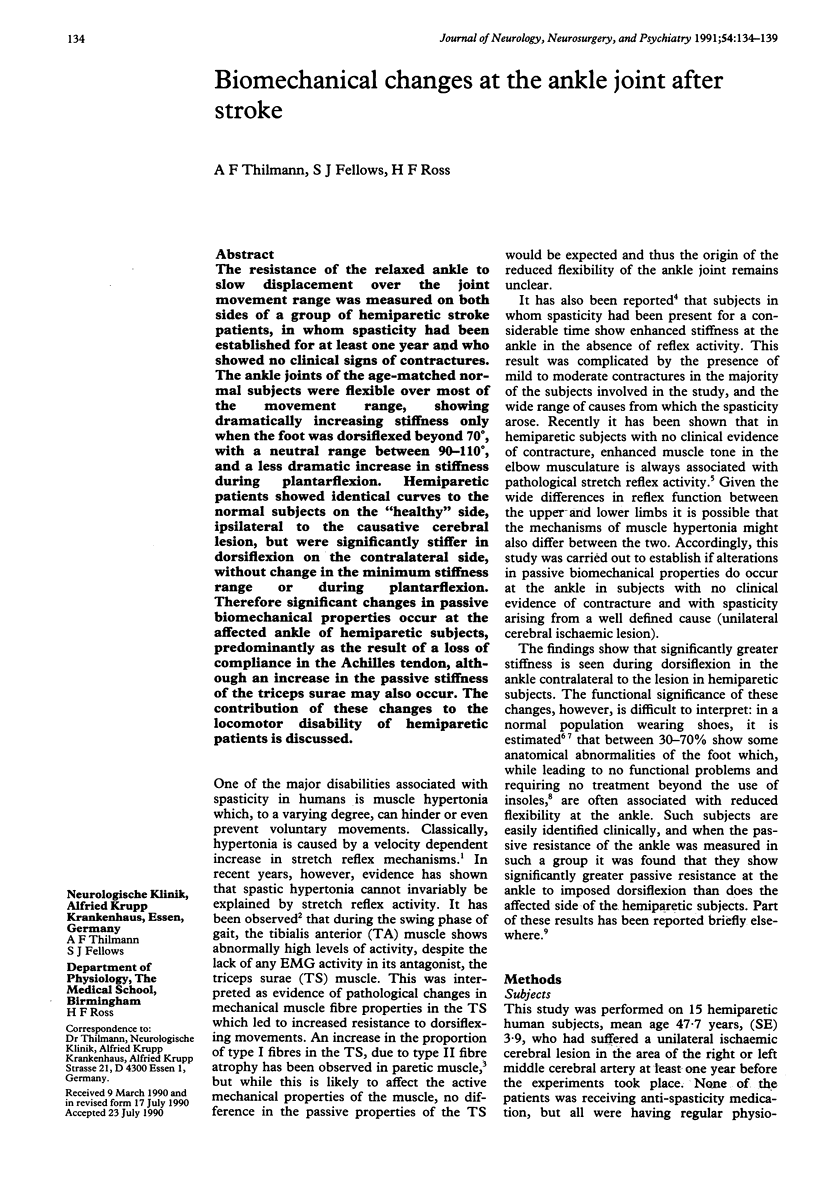
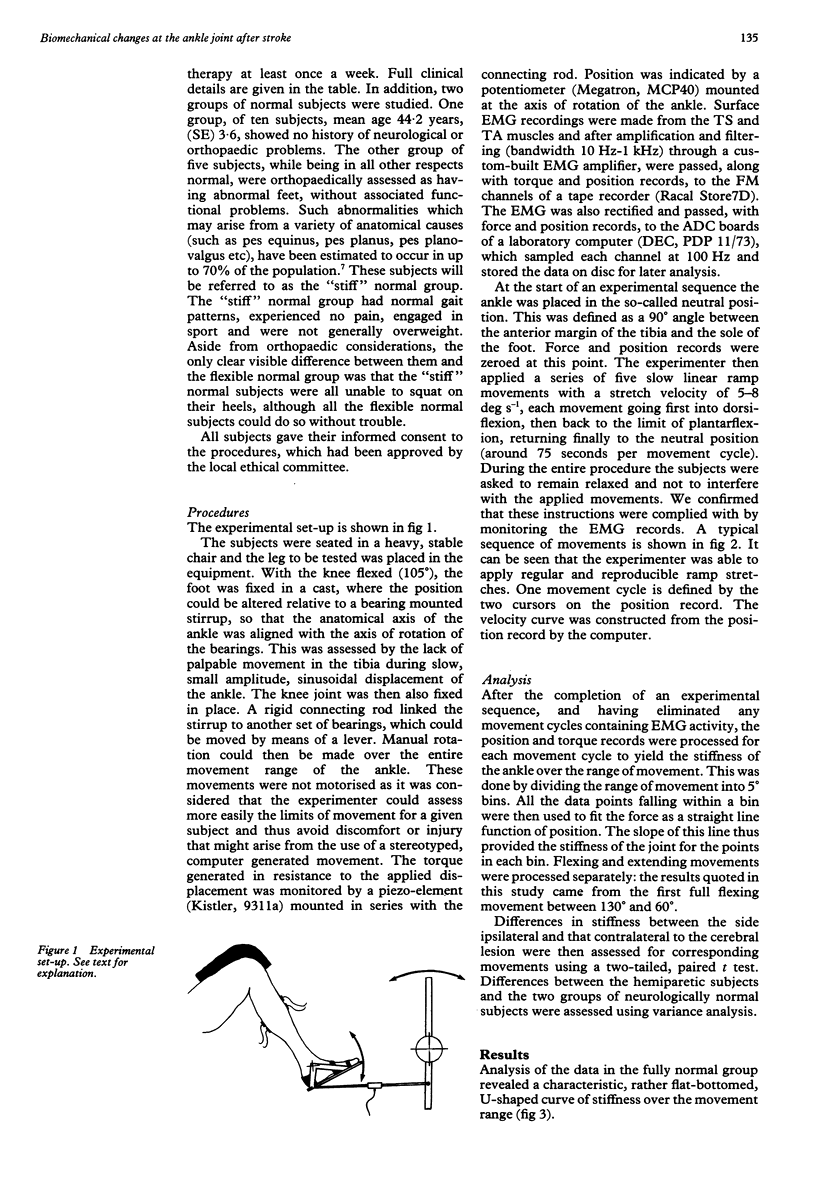
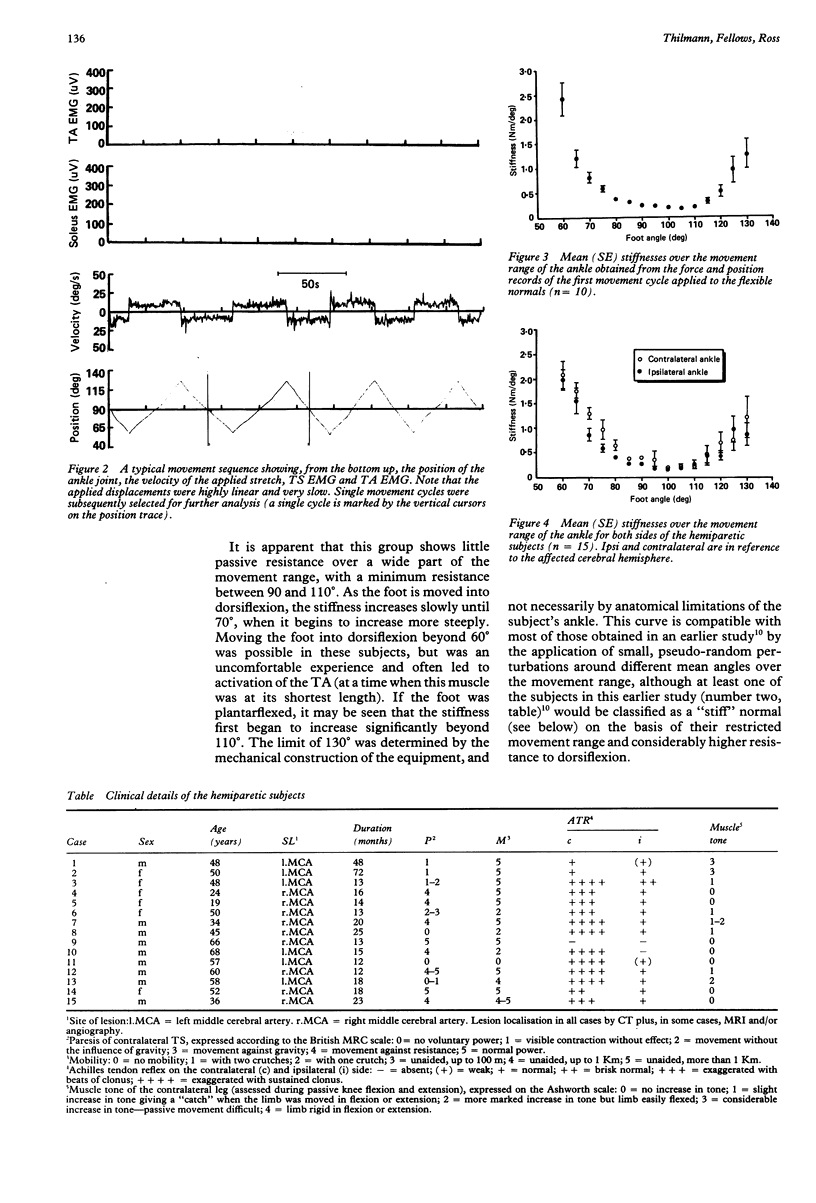
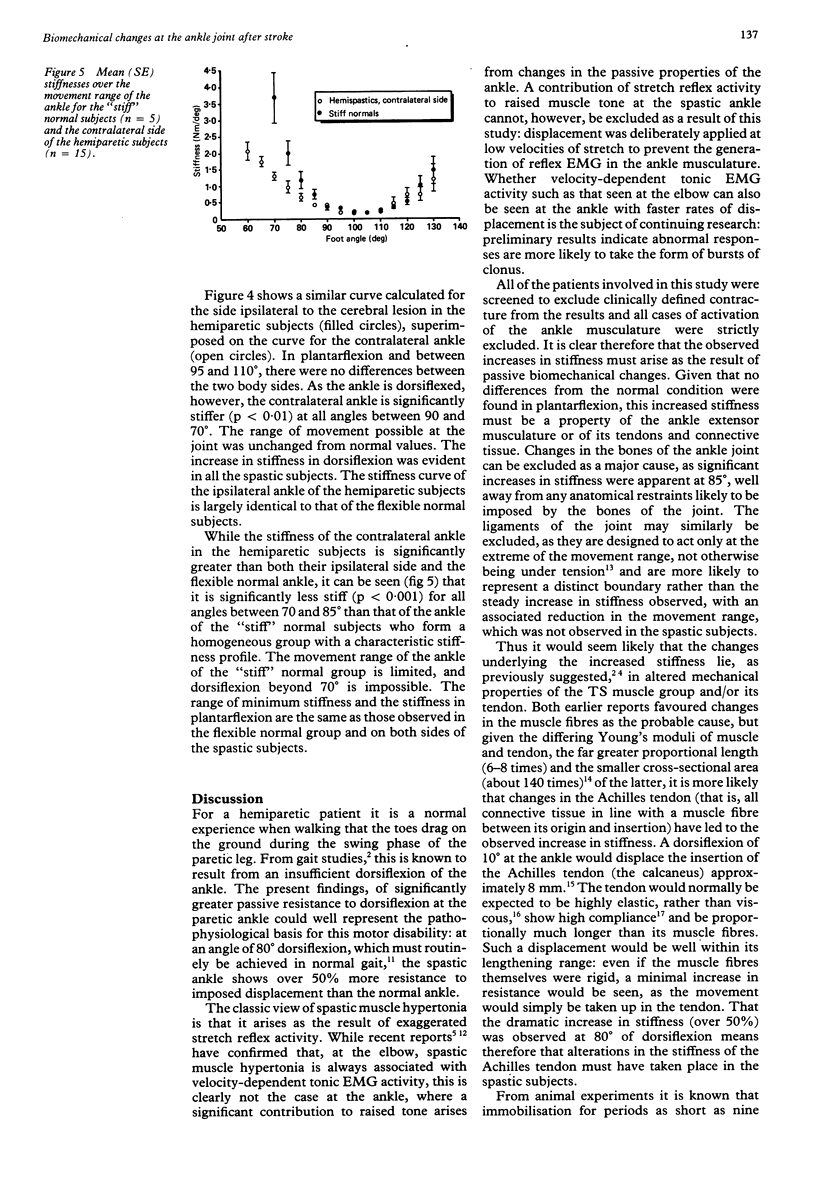
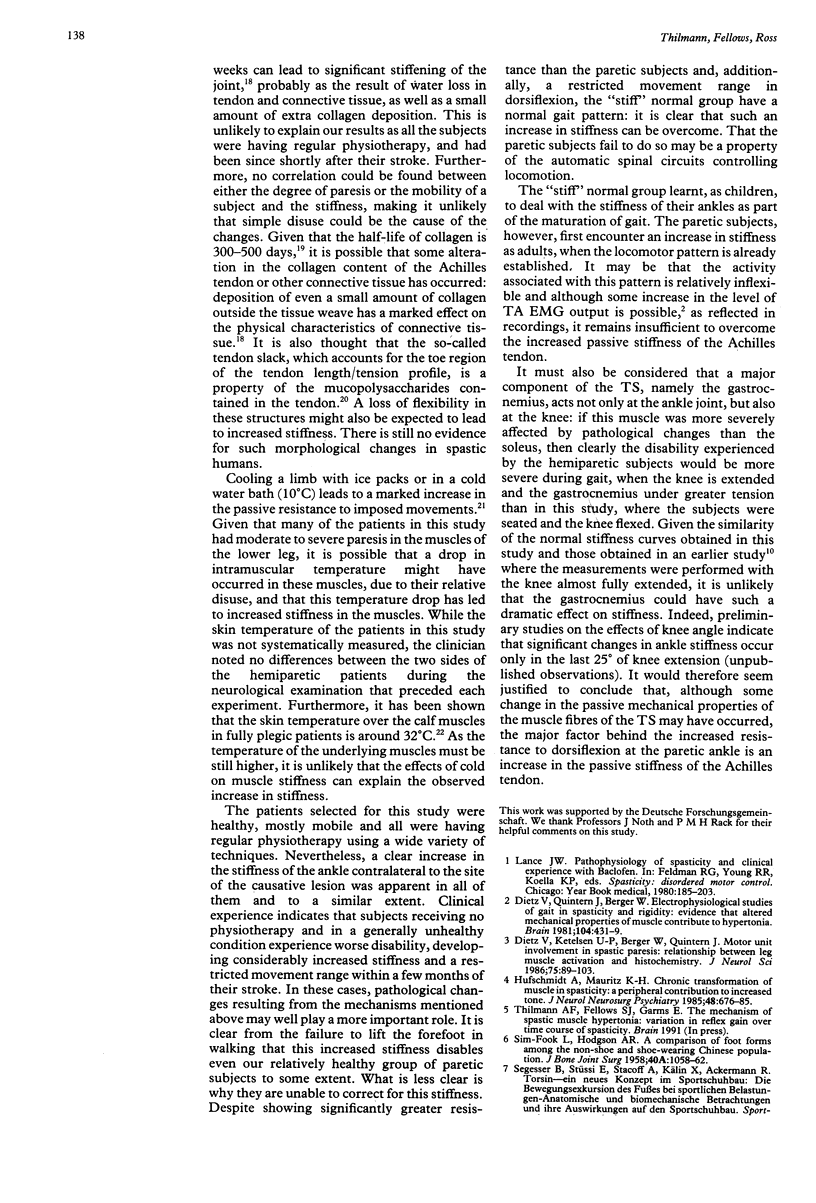

Selected References
These references are in PubMed. This may not be the complete list of references from this article.
- Akeson W. H., Woo S. L., Amiel D., Coutts R. D., Daniel D. The connective tissue response to immobility: biochemical changes in periarticular connective tissue of the immobilized rabbit knee. Clin Orthop Relat Res. 1973 Jun;(93):356–362. doi: 10.1097/00003086-197306000-00039. [DOI] [PubMed] [Google Scholar]
- Dietz V., Ketelsen U. P., Berger W., Quintern J. Motor unit involvement in spastic paresis. Relationship between leg muscle activation and histochemistry. J Neurol Sci. 1986 Aug;75(1):89–103. doi: 10.1016/0022-510x(86)90052-3. [DOI] [PubMed] [Google Scholar]
- Dietz V., Quintern J., Berger W. Electrophysiological studies of gait in spasticity and rigidity. Evidence that altered mechanical properties of muscle contribute to hypertonia. Brain. 1981 Sep;104(3):431–449. doi: 10.1093/brain/104.3.431. [DOI] [PubMed] [Google Scholar]
- ELLIOTT D. H. STRUCTURE AND FUNCTION OF MAMMALIAN TENDON. Biol Rev Camb Philos Soc. 1965 Aug;40:392–421. doi: 10.1111/j.1469-185x.1965.tb00808.x. [DOI] [PubMed] [Google Scholar]
- Hufschmidt A., Mauritz K. H. Chronic transformation of muscle in spasticity: a peripheral contribution to increased tone. J Neurol Neurosurg Psychiatry. 1985 Jul;48(7):676–685. doi: 10.1136/jnnp.48.7.676. [DOI] [PMC free article] [PubMed] [Google Scholar]
- Ker R. F. Dynamic tensile properties of the plantaris tendon of sheep (Ovis aries). J Exp Biol. 1981 Aug;93:283–302. doi: 10.1242/jeb.93.1.283. [DOI] [PubMed] [Google Scholar]
- Lakie M., Walsh E. G., Wright G. W. Control and postural thixotropy of the forearm muscles: changes caused by cold. J Neurol Neurosurg Psychiatry. 1986 Jan;49(1):69–76. doi: 10.1136/jnnp.49.1.69. [DOI] [PMC free article] [PubMed] [Google Scholar]
- Lightfoot E., Verrier M., Ashby P. Neurophysiological effects of prolonged cooling of the calf in patients with complete spinal transection. Phys Ther. 1975 Mar;55(3):251–258. doi: 10.1093/ptj/55.3.251. [DOI] [PubMed] [Google Scholar]
- NEUBERGER A., SLACK H. G. B. The metabolism of collagen from liver, bone, skin and tendon in the normal rat. Biochem J. 1953 Jan;53(1):47–52. doi: 10.1042/bj0530047. [DOI] [PMC free article] [PubMed] [Google Scholar]
- SIM-FOOK L., HODGSON A. R. A comparison of foot forms among the non-shoe and shoe-wearing Chinese population. J Bone Joint Surg Am. 1958 Oct;40-A(5):1058–1062. [PubMed] [Google Scholar]
- Sutherland D. H., Hagy J. L. Measurement of gait movements from motion picture film. J Bone Joint Surg Am. 1972 Jun;54(4):787–797. [PubMed] [Google Scholar]
- Weiss P. L., Kearney R. E., Hunter I. W. Position dependence of ankle joint dynamics--I. Passive mechanics. J Biomech. 1986;19(9):727–735. doi: 10.1016/0021-9290(86)90196-x. [DOI] [PubMed] [Google Scholar]


